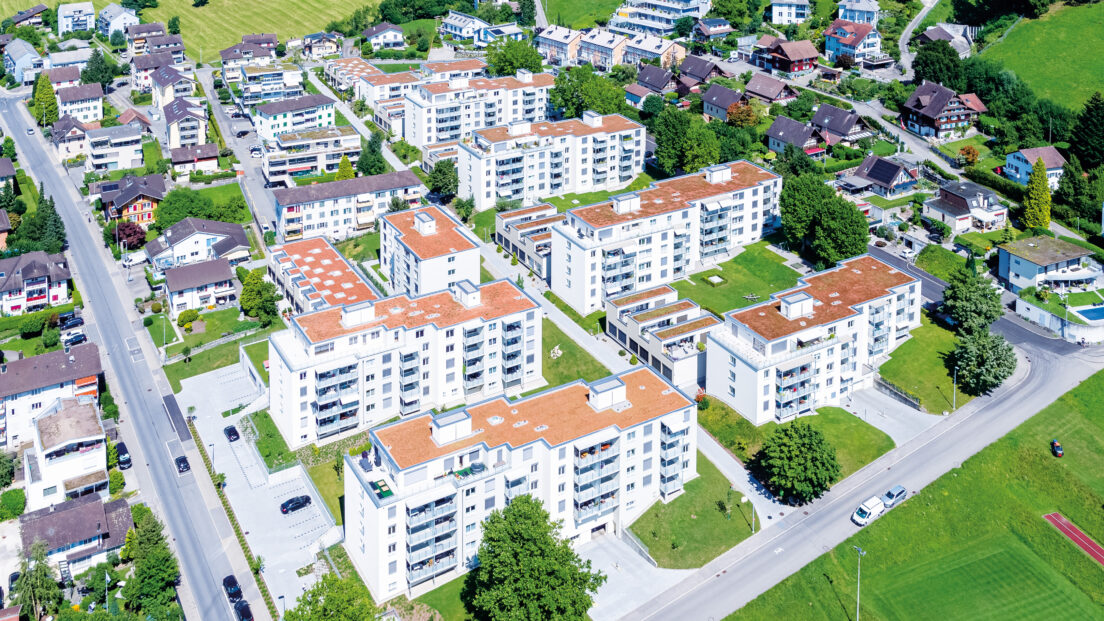Pension funds: Out of bounds with real estate

One in three Swiss pension funds held more real estate investments than the regulations allow at the end of last year. This is shown by data exclusively available to finews.ch. Now the pension funds want to correct the situation - but the boom in the real estate market has now faded.
Everything is relative: for pension fund managers, the quote attributed to Nobel Prize winner Albert Einstein may have a special ring at the moment. Their investments in shares and bonds have lost a lot of value in the past year. Positions in real estate, on the other hand, suffered less. As a result, these have – relatively speaking – often gained significantly in weight in the investment portfolio of the pension funds. This has not only theoretical but also tangible consequences.
At the end of last year, market observers warned that a quarter of the pension funds in Switzerland would have to sell or devalue real estate investments because their weight exceeded the requirements of the Ordinance on Retirement, Survivors’ and Disability Pension Plans (BVV2). The ordinances prescribe a fixed quota for real estate investments that may not exceed 30 per cent.
“A few pension funds had bandwidth violations“
Heinz Rothacher, CEO of the well-known St.Gallen pension fund consulting firm Complementa, now tells finews.ch that the quota violations at the end of 2022 turned out to be even more extensive than feared. “More than a third of the pension funds have reported a real estate quota of over 30 percent,” says the market expert (see chart below). And he notes, “There are a few pension funds that had a bandwidth violation due to the increase in ratios.”
In fact, the OOB2 ordinance allows certain bandwidths in the portfolio shares according to which the pension funds can design their investment strategy. But even this leeway has limits. When the edge of the bands is touched, there are therefore two tactics: Sit it out or correct it.
Maintain quota for now
The pension funds have apparently opted for the former as a first step. “Since it is a passive violation of the bands, they tolerated it and decided to maintain the existing quota,” Rothacher reports. The same applies to violations of the BVV2 limit of 30 percent, he adds.
Complementa has asked a good 150 decision-makers in occupational pension schemes specifically about the problem; the CEO therefore knows pretty well in which direction the industry is heading. As of the end of 2022, the real estate ratio averaged 24.1 percent, 3 percentage points higher than the previous year.
The wait-and-see approach has not worked badly for the pension funds so far. The real estate quota has been reduced again this year due to the positive performance of the stock markets, Rothacher reports. As a result, “the breach of the bandwidths has been partially remedied.”
Current surveys by Credit Suisse show that the Swiss pension funds generated an average investment return of 3.86 percent by the end of last June; the major bank UBS comes to an average performance after deduction of fees of 3.51 percent in its measurements. This means that the funds have already exceeded the statutory minimum distribution of 1 per cent per year.
The crux with illiquidity
Nevertheless, the problem has not disappeared, and the pension funds must be concerned about keeping within the defined bandwidths in the medium term due to their investment strategy. Another sticking point arises: Due to the illiquidity of the asset class – for example, directly held properties or investment foundations – it is difficult to adjust the ratio in the short term.
Accordingly, the funds have to tackle where liquidity is most likely to be available: in listed real estate investments. As Rothacher from Complementa reports, there is now movement to be seen there. “37 percent of the funds that participated in the survey are planning to reduce listed real estate funds,” explains the financial professional. As many as 11 per cent of the respondents are also thinking about reducing non-listed vessels.
Redemption fees increased
As it turns out, the prices of Swiss real estate funds have already fallen sharply in 2022. The relevant SIX Real Estate Funds Broad Index (SWIIT) lost more than 15 percent of its value last year. This year, the counter stagnated. Meanwhile, a lower demand for additional investments is noticeable among the non-listed investment groups, explains Rothacher.
Various real estate funds have also received significantly fewer commitments than planned for capital increases. “Not long ago, oversubscriptions were the norm,” he recalls.
The Complementa CEO does not expect major sales of such vehicles. On the other hand, he knows of individual investment groups that have already increased redemption fees this year – also with the reference to wanting to protect existing investors. This can have a deterrent effect on sellers. “The redemption fees for the various investment vehicles vary greatly and can sometimes account for a large part of an annual performance,” Rothacher knows.
When do appraisers resort to red pencils?
But even those who stubbornly hold on to their real estate positions may have to let down their guard. This is the case if there are valuation corrections because the real estate appraisers would be forced to raise the discount rates due to further interest rate steps.
At least on the Swiss market, the current low level of construction activity, immigration and rising rents make such measures appear premature. However, further interest rate hikes by the Swiss National Bank could still lead the appraisers to apply the red pencil.
Local pension funds often have a pronounced “home bias” in their real estate investments and would probably be sensitive to a decline in valuations.